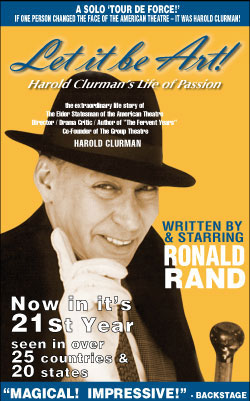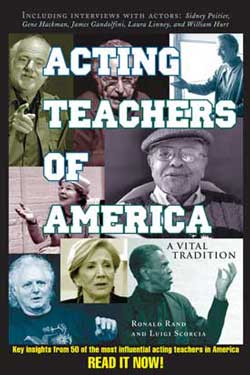Karen Saillant
Karen Saillant with students of International Opera Theater
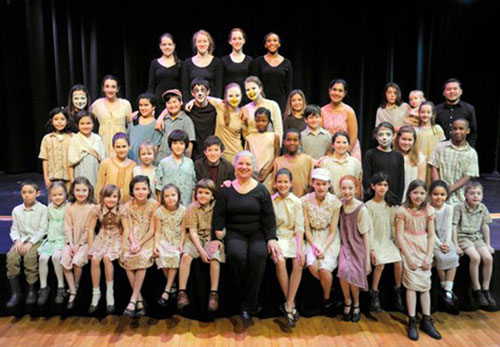
Artistic Director of International Opera Theater (IOT), based in Philadelphia, every year has presented world premiere Italian operatic premieres, some adaptations of Shakespeare texts, every summer in Citta' della Pieve, on the border of Umbria and Tuscany in Italy. Ms. Saillant has starred in opera houses in Europe and across the U.S., where she has received standing ovations. In 1976, Ms. Saillant became the first American to represent the U.S. in The International Opera Competition in Sofia, Bulgaria. She was the first opera singer presented in a New York recital debut by The Stough Institute of Breathing Coordination. As a vocal coach, respiratory specialist and stage director, Ms. Saillant has spent more than five decades guiding singers and actors in the creation and performance of classic and original works of art. She has worked extensively giving master classes in Italy and private sessions at a Philadelphia medical facility, helping individuals with asthma, emphysema and all types of breathing and vocal disorders. She began her study with Carl Stough in 1972. International Opera Theater has created sixteen world premiere Italian operas at Teatro degli Avvaloranti, Citta' della Pieve in Italy. In 1987, Ms. Saillant was commissioned by The Smithsonian Institution in Washington, The Museum of Modern Art in New York and The Philadelphia Museum of Art to create new works of theater and music to highlight their collections. The Philadelphia Orchestra commissioned her to create and direct a new theatrical representation of “The Pulcinella Suite” by Igor Stravinsky for their family concert series in celebration of the 150th anniversary of The Academy of Music in Philadelphia. In 2013, IOT presented the American premiere of Jago,” based on an original story by Karen Saillant, in Philadelphia, and the world premiere of "Camille Claudel" in Italy. In 2014, IOT presented the world premiere of “Azaio,” in both Italy and Philadelphia, based on an original story by Karen Saillant and her son, Christian Bygott. Since 2015, Ms. Saillant has been writing and producing world premiere cantatas for premiere at The Assisi Suono Sacro Festival. 2019 marked the 16th year Ms. Saillant has directed and produced a total of sixteen world premieres of Italian opera in Italy. Additionally, her new works have been presented at The International Festival of Culture in Bergamo, Teatro Mancinelli in Orvieto, Teatro Comunale in Citta' di Saluzzo, Teatro Valle (Rome’s oldest opera house), and in Philadelphia at The Rosenbach Museum, The Ibrahim Theater, Gershman Hall, Prince Music Theater,The National Constitution Center and Verizon Hall at The Kimmel Center. www.internationaloperatheater.org
You’re also the owner of “The Fire,” Philadelphia's Oldest original music venue, celebrating over twenty years, and it’s also where John Legend, Maroon 5, My Chemical Romance, Jason Mraz, and other well-known groups have played. This has been a most challenging time. How have you found a way to keep connecting people together.
During the pandemic, my younger son, Christian, and I have been creating online concerts to bring musicians together from different genres and different countries. It has been very rewarding to do this with our World Unity Concerts every Monday. We have had as many as 17 countries represented in one concert with 8 genres of music, including everything from heavy metal, to chamber music to punk to opera.
It is strange to be so connected to music here, as it was never my husband's idea to have a music venue. He and I started out owning The Philadelphia Bar and Grille together. (You can see the image of our place at the beginning of Tom Hanks movie "Philadelphia" when the camera pans up onto our sign to set the scene in Philly.) My husband basically wanted an old Wild West Saloon, just without the guns. He was a Teamsters and a sports fan.
I continued to sing, and worked with young artists as a vocal coach, while raising our sons. Tragedy struck, when my husband tried to stop a homeless person from a vicious attack on me and my son. My husband survived, but fell into a coma, after twenty-seven minutes without a pulse. He was revived by remained in a vegetative coma in the living room of our home where we took care of him, and he remained that way until his death, a year and a half later.
I really wish we could come together and break down the barriers that stand in our way. To finally see how much, we all share. I feel this idea is an important element of what we seek to achieve with our operas. I was able to get my husband off the ventilator and reassure the doctors that I could keep him breathing through Breathing Coordination. He breathed on his own till he died.
After I worked with my husband, non- verbal communication became one of the most important aspects of my work. While in Italy creating one of my operas, I was invited to work with the most severely disabled young people in Umbria. I was given the honor to create a theatrical piece with them. No one believed it was actually possible. They were all non-verbal. Only one could even begin to follow directions.
I was able to succeed, because I had had those experiences with my husband. To have lived in the kind of world I had experienced with my husband enabled me to enter another reality. That was the dimension from which I communicated with these young people.
I thought the reason I had decided to continue “The Fire,” was because of the music, but I was to eventually realize it was actually because of my husband. To have a nurturing, community gathering place had been his dream. My younger son and I are now spending our time now helping to fulfill that dream.
We live upstairs now. It is a way to honor my husband and his passion.
You’ve taught for more than fifty years creating innovative artistic works exploring music, dance and the visual arts and at the same time, believing they can all exist together in a harmony similar to that expressed in nature. Can you describe what you’re working towards in your work.
I am working to help develop a new generation of intuitively expressive operatic artists. The future of opera is in the hands of our children/ I believe training children who participate in our world premiere opera productions, singing alongside of professional opera singers, is one of the best ways to achieve this goal.. My personal love for language and movement began when I was a young child of four; I was originally a non-stop dancer, and then I began studying piano. By the time I was eight, I had received a full scholarship to Settlement Music School, and at twelve, I was taking voice lessons. By the time I was sixteen years old, I had successfully gathered the kids in the neighborhood to be my students, creating all sorts of weekly presentations. Since then I have always tried to include children in my work.
My dream has been to have the audience filled with people from different cultures and to create works which would be able to be understood by this diverse audience, no matter what their culture – to expand the frame of reference of the audience and allow for their transformation and healing. I don’t use subtitles. I want the audience to let down their defenses and feel. To feel comfortable with not knowing. Music, dance and theater are able to come together to create a harmony that is very close to Wagner’s conception of total art. And total art, when the artists are in harmony with nature, can be transformative for all involved.
Opera has the greatest potential of all the art forms to heal, but in order to fulfill its potential, the singers and other artists involved must seek to be in harmony with nature. Having your mouth as wide open as possible, or using forced breath or other excessive tensions, is not being in harmony with nature. Learning how to use your body as an expressive non-verbal communication element on the stage is beautiful.To have deep intuitive understanding, authenticity,and vocal and physical spontaneity helps enable an artist to communicate non-verbally, as in a kind of vocally expressive Caravaggio painting.
It starts from the freedom that the actor can find in herself, her own truth, devoid of judgment. Only through finding this fundamental center, will the actor be able to share with the audience true art. It’s a coming together of their energy and all the energies being created, and together creating a new, holistic communal energy in the space.
When I grew up, we understood the story before we began to sing the opera. We sought to understand the meaning of the words and the character, before we even ventured to learn the music. I believe, by allowing the meaning of the words to enter into your body, the artist is able to become an extension of the storytelling on a very deep unconscious level. Sounds have symbolisms and language is a very powerful tool. How we utilize our articulators, using only the energy required – never exaggerating or going out of balance- that is our goal.
Opera singers don’t think much about their body as an expressive storytelling element, but it truly is and even today, body language is becoming a respected form of communication. My goal is that our singers learn to become deeply sensitive to one another and interact non-verbally, so they can create unconscious consensus, something that is so beautiful to witness onstage and even more gorgeous to see in life.
When an audience experiences this unconscious consensus happening onstage, they are unconsciously inspired to return to society and bring along with them this gorgeous ability of harmonious interaction and agreement, where all are accepted, heard and respected, all for the common good of the community and, eventually, for themselves individually.
Witnessing this harmonious living and working together onstage is the ultimate inspiration for us as human beings in our daily interactions. It is an honor to devote my life to this objective, especially to help support those who wish to bring healing and catharsis to the operatic experience.
A band that plays metal music is not thinking about where they’re placing their tone. They’re making music and they’re present in the moment with each other on the stage. My wish would be for opera singers to be as authentic and present and sensitive to each other.
In the past five decades, you have created hundreds of performances with children singing in foreign languages. More than seventy children have come to your opera house in Citta’ della Pieve, Italy to sing in eleven of your sixteen opera premieres. This includes “Aza’io,” your first Italian children’s opera, with fifteen children, none of whom had ever studied Italian.
As far as I know, we’re the only company in the world to regularly include children at the side of professional adult opera singers in world premiere Italian operas. We’re the only opera company creating new Italian opera where the singers understand the sound symbolism of the Italian language, which is powerful on an unconscious level. Through the Italian language, the rebuilding of one’s natural instinct is possible, especially when surrounded with nature as we are in our gorgeous town of Citta' della Pieve, in the hills of Umbria.
Before Carl Stough’s death, you were designated as one of a small number of his students to carry on his work. Stough's legacy was immortalized through forty years of ground-breaking rehabilitation for thousands of patients in the field of emphysema. At the 1968 XIX Olympic Games in Mexico City, the track and field team he had coached in breathing received more gold medals than in any other Olympics, setting records that would last twenty-five years, becoming the only team to not need oxygen in the high altitudes of Mexico City.
Carl Stough was a successful choral director, and he did the first seminal work in the field of breath. It takes time and patience and the help of someone who understands the principles of coordinated breath upon which the respiratory system is meant to work in order to return a dis-coordinated respiratory system into coordination.
Carl’s forty years of research gave us our first look into the internal mechanics of breathing. Carl discovered the actual way the body is meant to breath. He called his discovery ‘Breathing Coordination.’ A key to his discovery is that the inhalation is a reflex. We never “take a breath.”
Carl devoted a large part of his life to help chronically ill patients improve the health of their respiratory system, and improve their breathing coordination. Despite resistance and skepticism, he patiently moved forward, creating a series of isometric exercises that strengthened the diaphragm while allowing minimal engagement of the voluntary muscles of respiration, allowing the ribs to fold evenly and equally on all surfaces of the lungs creating synergy, or what he termed ‘Breathing Coordination.’
As the patient developed the capacity to express a group of sounds during exhalation, without tensing the abdomen, the ‘Breathing Coordination’ was primed and the coordination was able to eventually return. All of Carl’s patients improved. Carl’s background in voice gave him the idea that he might be making a change in the diaphragm. Cinefluorographic films of the diaphragms of his recovered patients in Army medical hospitals, which we have on video, would prove him to be right.
Breathing coordination is a major key to good health.
This statement is related to the importance Kristin Linklater gives to “the primary impulse.” Carl insisted, as does Linklater, that ‘breath holding’ is at the heart of all respiratory problems. We are holding our breath and we’re not aware of it. ‘Breath holding’ leads to respiratory disease.
That is why it is so important to silent count, as Carl suggested, when under stress, as we are probably holding our breath. Silent counting assures us that the exhalation is active- that we are not holding our breath. Also, silent counting enables the diaphragm to slowly rebuild, as long as we do not go into using voluntary muscle- which we can determine by noticing if there is tension in our abdomen. The abdomen should always be relaxed. It only tenses when the diaphragm is being dominated by voluntary muscles. The key is to allow the automatic inhale to occur before voluntary muscles take over the activity of the weakened involuntary diaphragm.
So many people hold their breath in yoga class or while swimming or exercising. Carl worked with many swimmers who had serious respiratory disease. ‘Breath holding’ creates a very, very serious problem for the respiratory system of the individual who is doing the holding. Everyone needs to be sensitive to their own breath, especially their abdomen. When the abdomen is tense, this means the diaphragm is not rising. The diaphragm must be in constant motion for optimum health.

Production of “Bambina Mistica” by Hildegard von Bingen in Italy, photo by Ornella Tiberi
How did you decide to use net fabric to help free actors during rehearsals?
All of the ideas I speak about using, as well as the exercises I have developed, other than those related to Breathing Coordination, popped into my mind. I didn’t learn them from any person or read about them in any book. They came to me,or I discovered them through experience. When I work with the singers, I have them sing and move with a huge section of cheap net fabric- about 40 yards. I use this fabric in many of the exercises, to help singers return to their primary impulse, so they respond spontaneously and connect to "flow".

Production of “Bambina Mistica” by Hildegard von Bingen in Italy, photo by Ornella Tiberi
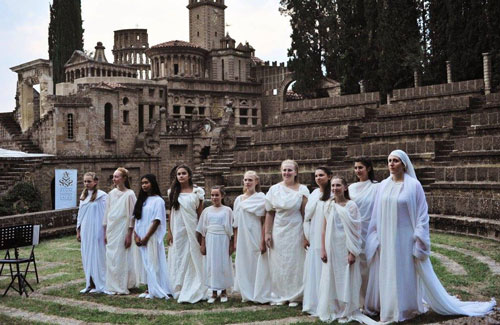
Production of “Bambina Mistica” by Hildegard von Bingen in Italy, photo by Ornella Tiberi
I am able to see immediately if the singer understands metaphor, simply by observing the way in which they move the fabric. If they use it in a literal way, rather than in a continuously flowing manner, then I know they are in their left brain and are thinking consciously about what they are doing. One of my goals is that all artists on my stage are able to self-organize themselves with each other. This is so beautiful to witness. It’s magical! To achieve this goal while "thinking" is not possible.
During the casting for the role of Giulietta in “Romeo e Giulietta,” I gave a young soprano a large piece of net fabric and asked her to move the fabric as she sang. She moved the fabric with such depth of understanding, continuously and slowly, exactly in sync with the underlying movement of the music, that she brought me to tears. In all my years of auditioning, I have never had such an experience.
Of course, we cast her in the leading role and she was truly magnificent, often bringing me to tears during rehearsals as well as performances. Why? Because she made visually evident the underlying and continuous movement of the music. She had contact with this movement. This is the true power of music – not that it goes high or low, or that it moves fast or slow or gets louder and softer, but that during all of these changes, there is one continuous underlying movement and no matter what goes on over that movement, underlying it all is a deeply serene, forward movement, which never, ever stops.
What a powerful message for all of us! This humble and beautiful young soprano was able to visually share that truth. This experience was so healing and powerful for everyone in her presence.
To me, the fabric is the most amazing conduit because it is able to allow the unconscious mind to be free and connect to the underlying movement of the music, but only if the actor is able to be sensitive and free enough to surrender to this mystery.
The fabric I use is cheap nylon net fabric, not tulle. For some reason, which I do not understand, it has to be this cheap net. It is strong, yet beautiful. It is capable of standing alone and creating sculptures in the presence of the audience, yet it also has a fluidity There’s no way of knowing if each person will be open for the underlying movement to reveal itself. This knowing comes from a mystical place that cannot be explained. It does not come through logic. It’s very humbling, and it’s very inspiring to know that such a metaphysical process of reassurance exists, especially if we’re sensitive enough to allow it to reveal itself.
I also use quick-change exercises with the singers touching each other on as many surfaces as possible and then quickly changing to a completely different part of the group, in a completely different position and plain to do the same thing with other artists. I believe these exercises. allow the artists to access all the history of the other artists in the group so they can understand each other non-verbally.
These exercises provide the basis for the self-organization that is requested of the artists during the staging of the scenes, as each artist has a very deep understanding of each one of their colleagues, on a very instinctual level. After working in these processes in Italy, many of our artists become very good friends with each other for life. After all, this is a very fast way to develop trust, compassion, empathy and understanding. What better way to build ‘community.’
You’ve talked about that working with students, “The starting point is not knowing.” How does this enable the student to discover their abilities?
One of my goals is to create something that has never been seen before. If we knew what it was, how could it never have been seen before). This concept comes from the Commedia dell’arte. I learned this from Maestro Antonio Fava, a great teacher, artist, musician and actor. It’s really where all modern actors come from. Commedia actors gave the first performances indoors during The Renaissance. Tickets were sold for the performances, and the actors were paid. Commedia became the highest form of theater in Italy. It was not the street theater that we usually think of when we hear the words, Commedia dell’arte. I want to create a similar experience for the audience.
Through my work, the actors learn to trust their ability to discover – allowing for vulnerability. From vulnerability, come ideas they might never have known before and they come spontaneously. They pop into the mind from the “not-knowing” part of ourselves. It takes enormous courage to trust these impulses, as they might make no sense at all. They usually defy logic and they absolutely do not communicate the literal meaning of the text. This is an aspect of my work that can really infuriate literal thinkers, but my work is about art, not about show and tell opera.

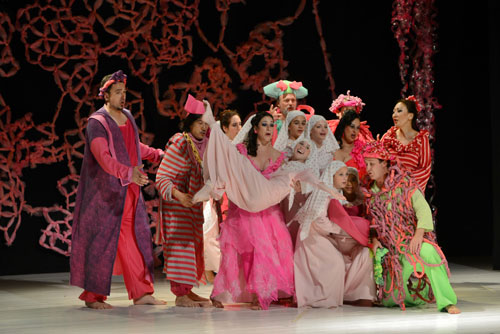
Production of “Errori” in Italy, photo by Ornella Tiberi
Additionally, a path or a link can be created between my imagination and the actor’s ability and it can deepen through a ‘melding.’ This was a behavior that I had unknowingly practiced when I took care of my husband.
Almost immediately in “Acquaiola,” I found myself going into this state with the actors who were non-verbal and could not follow directions. In this state, I was able to communicate, to transfer a possibility into the imagination of the actor. This created a link through which each actor, some more successfully than others, could see into the reality of the present and have a glance at my reality – one that could shift between many different realities and offer unexpected possibilities- ones they had never before imagined in regard to themselves.
How did the idea of emanations come about in the way you work?
In Italy, my projects are very much about a process called ‘ausstrahung.’ It is a German word, and it means ‘emanation' or 'charisma.’ Most operas take a much longer time to create; we put our operas together in one month, bringing singers together from around the world and still able to accomplish the goal..
I think of the project in Italy as a sort of peace project, meaning that people from different cultures are coming together and finding a thread that unites them and that enables them, through intuition and rekindling instinct to make decisions very quickly on the stage. We bring each singer from a different culture, and together they make unconscious decisions together based on the collective unconscious of the group. That process of connecting through each other’s ‘ausstrahlung’ is accomplished through a series of exercises that I have developed over the last forty years.
Their interpretation of the music allows them to organize themselves on the stage in the same way that we organize ourselves in daily life. There is a basic plan, developed through improvisation in rehearsal, but the coming to that plan is the unconscious agreement of the director and the artists. There are always variations every night, but nothing that an audience member might notice as being very radically different.
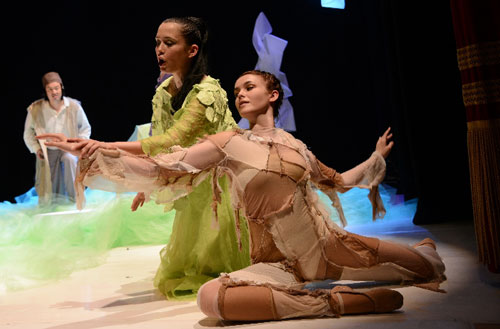
Production of “Camille Claudel” in Italy, photo by Ornella Tiberi
Ausstrahlung has been occurring since the beginning of time – simultaneous inventions are created or music is created that can take place in different parts of the world. It happens when composers are creating music. It happened when Stravinsky was creating his work – and similar music was being created in a different part of the world. There was no internet, but it’s in the ether, as when the radio was invented in two different parts of the world- these ideas can pop into the minds of like-minded artists in different places.
While we’re talking, your mind might be thinking of something other than what we’re talking about, an emanation can happen which can be related to a gesture or something you see or hear, and this idea happens when artists let their guard down and return to their natural instincts- to their primary impulses. It can also happen when we mirror someone else; through mirroring we can learn a great deal about one another and communicate large bodies of information in a very short period of time.
When I first meet with our actors onstage, I make a gesture and ask them to “do what I do.” Almost no one ever mirrors what I do. They’re almost all using logic rather than instinct. If I put up my right hand, they put up their right hand. They have learned this in school and through becoming “civilized.” My work seeks to “uncivilize” them.
We work to allow our artists to return to instinct, the ability to mirror, the power to communicate without words, the courage to not know and the promise to arrive at an even more beautiful place than had ever been imagined through knowing. When we’re working with our singers, it’s very important that there is not judgment or criticism.
A history is constantly being made, because there is constant change and discovery, so they don’t get stuck on the low points or the high points. I believe an artist must have constant, very slow movement of their hands while they’re singing. If the artist stops moving his or her hands, I believe it makes the audience unconsciously choke and takes them out of the artistic zone where healing can occur and into the conscious world of thought. When the audience is thinking, they are separating themselves from the whole and back into their own problems and analyzing – no longer part of the story – removed from catharsis.
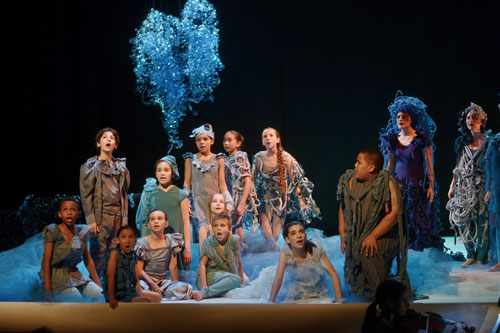
Production of “Azaio” in Italy, photo by Ornella Tiberi
How did you create your fascinating ‘principles for operatic photosynthesis', based on biomimicry, chart?
I wanted to define my work and name all the principles and I believed the principles were all based on being in harmony with nature – which is what I saw to be so severely missing from modern operatic performance. When I found the chart for biomimicry, I was so excited, because the principles of all of my work, which we had been realizing over the years, fit perfectly into the principles of nature. In accordance with nature, the idea that there are principles, as there are in performing.
As the director of our first Italian opera, I said to our costume designer, as I pointed to a plant that had little blueberries: “That’s the opera.” She just looked at me. My older son had to explain, “What my mom means…” And he used all these words, but I didn’t know how to explain it, as in those days, after so long with my husband in a coma day after day, I had become almost totally non-verbal.Putting these principles into words was greatly facilitated by knowing the principles of biomimicry.
One of the operas you presented with an Italian and American cast was “The Buffalo Soldier.” What led you to choose this subject? What kind of a learning experience was it for you?
I had the amazing good fortune to be invited to the African-American Museum in Philadelphia to see the presentation of “Inside Buffalo,” an hour-long documentary about the 92nd Segregated Infantry Division of the United States Army- The Buffalo Soldiers who served in Italy at the end of World War II. The Italian Consul was the co-sponsor of the film showing. The documentary had been written by African-Italian filmmaker, Fred Kudjo Kuwornu.


Buffalo Soldiers’ during WW II
These men had been part of the troops who liberated Italy. They were heroes to the people of Italy. The documentary was deeply moving to me. It described the tremendous service and sacrifice of these infantry men and how they made our freedom possible. But they had had to wait for over fifty years to receive the first Congressional Medal of Honor for their service. There were seven soldiers, but all were deceased except for one, Vernon Baker, only soldier able to come and receive his medal from President Clinton.
I was deeply moved by the subject matter. I knew a lot of people didn’t know about these soldiers. I said out loud: “I’m going to make an opera about this.” A woman next to me turned to me. Tears were streaming down my face; I was so moved by these men and all of the oppression they had faced, sometimes on the front lines without ammunition. Their courage and dedication was overwhelming.
The Buffalo soldiers were segregated; when they returned home, they were still not allowed to sit in the front of the bus or at tables with the white soldiers in the mess hall. They could only drink at fountains reserved for Black people. I wanted the opera to honor them and to be about hope and joy and to recognize their great contributions.
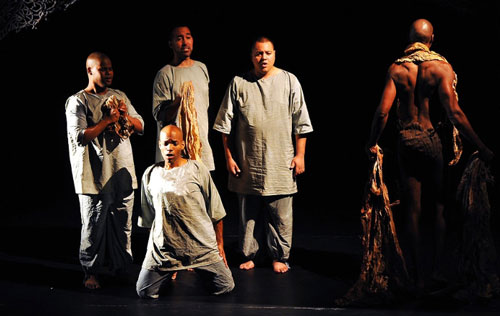
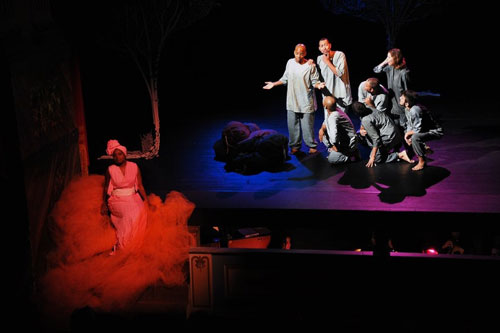
Production of “Buffalo Soldier” in Italy, photo by Ornella Tiberi
It turned into such a beautiful project. I began researching in order to createthe libretto and I was able to be in contact with the widow of Vernon Baker, one of these decorated ‘Buffalo Soldiers,’ and talk with her. We cried together on the phone and she told me how honored her husband would have been to have had an opera written about him, as he loved classical music and listened to it every day. I researched the Italian Partisans. I put their stories in the opera also.
Unfortunately, Didala Ghilarducci, the female Partisan with whom I had been in touch through email and actually spoken with on the telephone, who I had made a character in our opera, died suddenly before the opera was completed and was performed at Teatro degli Avvaloranti in Citta della Pieve and at Teatro Valle in Rome.
We didn’t have auditions and chose our singers through recommendations. The opera had Italians and African-American singers. We had very fine singers many recommended by George Shirley, the first African-American tenor to sing at the Metropolitan Opera. It was our first bilingual opera, written both in Italian and in English. It united our two cultures through a deeply emotional and profoundly moving story of courage, honor and sacrifice.

Curtain call of Production of “Buffalo Soldier” in Italy, photo by Ornella Tiberi
We were supposed to premiere our seventeenth world premiere Italian opera in August of 2020, to honor the 500th anniversary of the death of the great Renaissance painter, Raphael, who was a protege of Perugino (Pietro Vannucci), famed Renaissance painter, born in Citta’ della Pieve.
Our musical director, Italian Maestro Mauro Fabbri, had written the music and all was set to go, but the opera had to be cancelled, due to the virus restrictions preventing us from entering Italy. To honor International Opera Theater, the Municipality of Citta’ della Pieve, created a twenty-day celebration, from September tenth through the thirtieth of 2020, throughout the town to honor our sixteen years of world premiere Italian operas there.
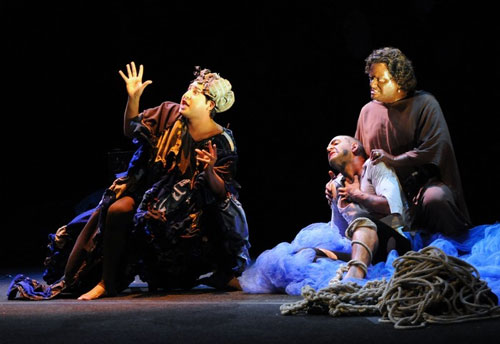
Production of “Jago” in Italy, photo by Ornella Tiberi
During your career you have starred at several opera houses, and I understand you have sung as an opera singer in seven languages?
Actually, eight. I had to sing in the Bulgarian language. I was the first Westerner to sing in the International Opera Competition, and represented the U.S. in 1976 in Bulgaria. I went to the Bulgarian Embassy in Washington to learn to pronounce the words properly, and learned the pronunciation by ear.
I know most people like to write words down phonetically. I like to develop my ear and learn through my ear. Our society is so visual. If you go to an opera, they have a film for you to watch. As a culture we need to listen more, that way, everyone will understand so much more.
I always ask our opera singers to first learn the text as if ‘they were a child,’. To be able to relate to the sound symbolism by beginning the learning process through hearing; adds an additional level to the meaning of what a singer is singing. And this is powerful.

Production of “Romeo e Giuletta” in Italy, photo by Ornella Tiberi
We need to make the invisible visible – the underlying movement of the music. This is something I believe that is so important – the constant underlying movement in music or a loud crescendo of that movement and how it continues. This gives you faith that everything will be all right.
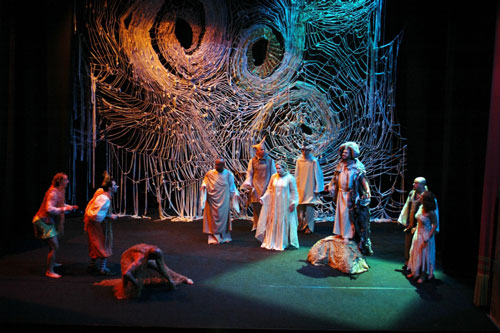
Production of “La Tempesta” in Italy, photo by Ornella Tiberi









































